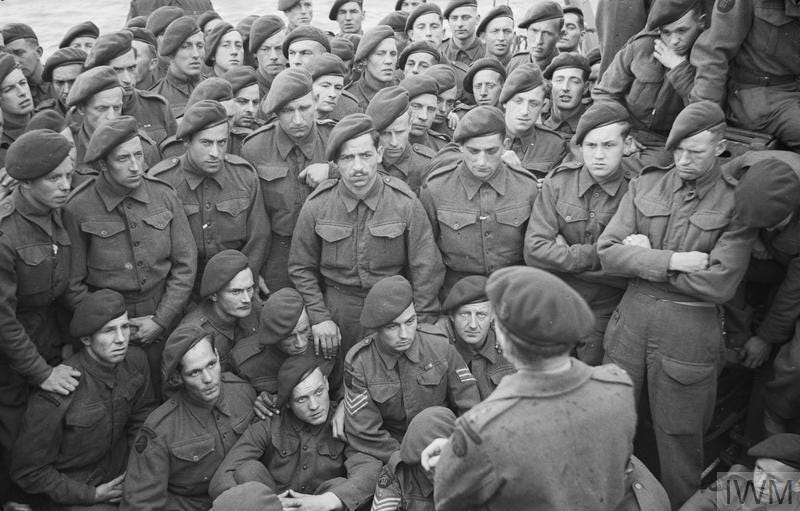D-Day (And The Dangerous Lie It Wasn't Necessary)
We owe it to the men who fought and died to combat false narratives
What happened?
June 6, seventy-nine years ago, marked the beginning of history’s largest naval invasion. American, British, and other Allied troops stormed the beaches of Normandy, marking a major milestone in the fight against Nazi Germany.
The invasion, known as Operation Overlord, involved more than 150,000 troops and thousands of ships. The world had not seen such a large amphibious assault since the Persian King Xerxes invaded Greece millennia before.
“Into The Jaws of Death,” by Chief Photographer's Mate Robert F. Sargent. U.S. Coast Guard/public domain.
The Soviets had already been fighting the Germans for several years on the Eastern Front, as had the western Allies in the Mediterranean, North Africa, and Italy. But D-Day marked the opening of the long-awaited Western Front, into which the Western Allies poured most of their efforts in the final push to defeat the Third Reich.
The campaign’s generals wanted to establish an enormous beachhead that could accommodate ever-increasing numbers of men, tanks, vehicles, and supplies for an offensive that would liberate Western Europe and eventually take the fight into Germany itself.
But creating a secure beachhead involved more than just drawing lines on a map. The men who stormed the beaches paid dearly for every bloody inch. The Nazis had been expecting an attack but were unsure about the precise location. Even though paratrooper landings and aerial bombardments preceded the invasion to soften up defenses, Allied troops still faced German resistance.
This was especially true for Omaha Beach, the sector reserved for the Americans, who had to fight through entrenched German positions. The total number of American dead is estimated at 2,499 (the campaign’s toll rises to roughly 4,400 when accounting for other nationalities), almost exactly the same death toll America incurred from twenty years of fighting in Afghanistan. The average age of the Allied soldiers was 26; the average age of those killed, just 19.
Men of 4 Commando, 1st Special Service Brigade, being briefed by Lt Col R Dawson just before embarking for Normandy, June 1944. Sgt. G Laws, British Army. Imperial War Museum.
The Allied troops managed to push back the German defenses, but the battle was not over. Facing the troops was a longer fight through the bocage, or hedgerows of Normandy, terrain excellently suited for the German defenders that posed a “a nightmare situation for Allied forces.” But despite the hard fighting ahead, the Allies succeeded in their goal: their beachhead was secure, the Germans did not shove them into the sea, and by the end of June, almost a million men stood poised to liberate France.
Why should you care?
D-Day was a major turning point in the war; it established the Second Front against Germany and prepared the final push that would liberate the long-suffering populations of Western Europe and topple the Swastika. The Normandy landings and subsequent fighting drained Nazi Germany of men, tanks, and supplies they couldn’t afford to lose.
Some historical revisionists claim that the Soviet Union did all of the “real effort” fighting the Nazis, and that America and its allies just “marched into Germany” after all the real work had already been done. In these critics’ minds, the Western Allies’ sacrifices were minor and the self-serving “myth of D-Day” exaggerates their heroism.
But this is an historically ignorant lie. The Allied invasion of Western Europe kept hundreds of thousands of German troops tied down, including elite formations such as the Panzer Lehr Division. Without D-Day and the battles that followed it, Germany could have sent these much-needed troops to the Eastern Front against the Soviets, prolonging the war and potentially costing millions more lives.
Landing ships after the fighting on Omaha Beach. U.S. Coast Guard/public domain.
The West had already been helping the Soviets even before the first American boots landed on France’s shores. Throughout the entire war, the Lend-Lease program provided the USSR with billions of dollars’ worth of jeeps, tanks, fuel, food, and other vital war supplies that kept the Soviets in the fight. No less a person than Soviet dictator Joseph Stalin himself said: “Without the machines we received through Lend-Lease, we would have lost the war.”.
Even if the Soviets had somehow managed to win the war on their own (which is unlikely), Europe’s future would have been bleak. When the Soviets “liberated” Eastern European countries like Poland from Germany’s grip, they imposed their own brutal brand of tyranny, installing communist dictatorships that dominated the region for the next half-century. Had no U.S. and Western Allied servicemen stood in the way of a Soviet advance into France, Western Europe would have faced the same fate.
A veteran of the 101st Airbone Division on June 3 2014. Yorgos Kourtakis/Flickr.
Fewer than three thousand veterans of the battle are thought to still live today. Many families in the U.S., UK, and other Allied nations have family members who fought in the heroic struggle to end Nazi tyranny. We owe it to them and to their comrades to remember their sacrifice and courage seventy-nine years later and to combat false historical narratives that diminish their achievements.









Thank you for this piece. The writing and images combined make me truly appreciate the bravery and sacrifices made and serve as a worthy defence to those who seek to rewrite history.